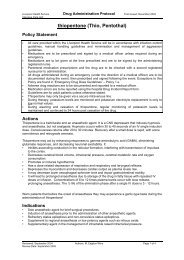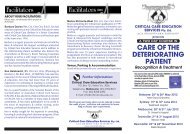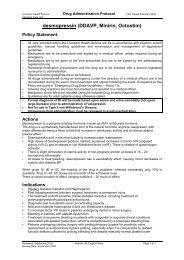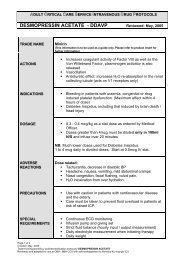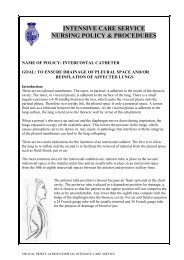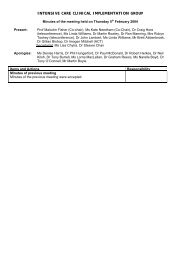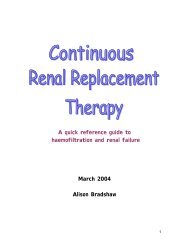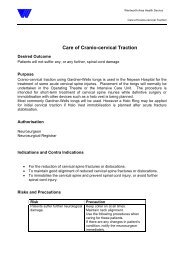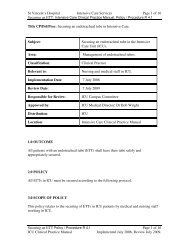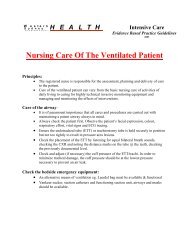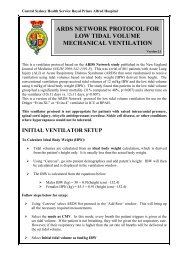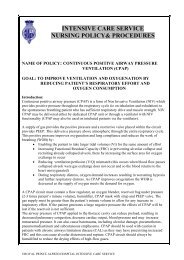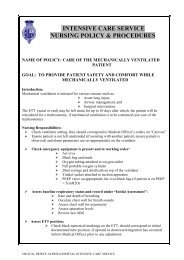Stabilisation of an Endotracheal Tube for the Adult Intensive Care ...
Stabilisation of an Endotracheal Tube for the Adult Intensive Care ...
Stabilisation of an Endotracheal Tube for the Adult Intensive Care ...
You also want an ePaper? Increase the reach of your titles
YUMPU automatically turns print PDFs into web optimized ePapers that Google loves.
Number<br />
4<br />
4a<br />
4b<br />
4c<br />
4d<br />
4e<br />
4f<br />
Statement: When to ch<strong>an</strong>ge ETT stabilisation<br />
method<br />
There is minimal research evidence to support <strong>the</strong><br />
frequency <strong>of</strong> renewal <strong>of</strong> ETT stabilisation methods. However<br />
<strong>the</strong>re are principles that support <strong>the</strong> decision about<br />
frequency.<br />
The ETT securing method should be renewed if <strong>the</strong> tapes<br />
are soiled.<br />
The ETT securing method should be renewed if <strong>the</strong> ETT is<br />
able to migrate/move more th<strong>an</strong> 1 cm.<br />
When using cotton tape <strong>the</strong> ETT securing method should be<br />
renewed if a clinici<strong>an</strong> is unable to insert two fingers<br />
between tape <strong>an</strong>d skin.<br />
The ETT securing method should be renewed if <strong>the</strong> ETT<br />
position on CXR is incorrect (tip should be 2.5cm above <strong>the</strong><br />
carina).<br />
The ETT securing method should be renewed if <strong>the</strong> method<br />
<strong>of</strong> tube stabilisation is not consistent with Unit practice.<br />
In <strong>the</strong> absence <strong>of</strong> o<strong>the</strong>r indications <strong>the</strong> tube stabilisation<br />
method should be renewed at least once every 24 hrs to<br />
enable skin <strong>an</strong>d mucosal assessment <strong>an</strong>d to prevent<br />
sustained pressure on a single point.<br />
Grade <strong>of</strong><br />
14<br />
recommendation<br />
Consensus Opinion<br />
Consensus Opinion<br />
Consensus Opinion<br />
Consensus Opinion<br />
Consensus Opinion<br />
Consensus Opinion<br />
Consensus Opinion<br />
The period during renewal <strong>of</strong> ETT stabilisation methods is a time <strong>of</strong> increased risk <strong>of</strong> UEX<br />
<strong>the</strong>re<strong>for</strong>e <strong>the</strong> decision to carry out this procedure must be made on <strong>the</strong> basis <strong>of</strong> clinical need<br />
<strong>an</strong>d when <strong>the</strong> patient’s condition is stable. However despite <strong>the</strong> centrality <strong>of</strong> this practice to<br />
intensive care nursing <strong>the</strong>re was no research evidence or textbook recommendation<br />
identified to frame recommendations concerning when <strong>an</strong>d how frequently to renew <strong>the</strong><br />
method <strong>of</strong> ETT stabilisation. There<strong>for</strong>e <strong>the</strong> GDN members developed <strong>the</strong>se recommendations<br />
through discussion.<br />
The ETT stabilisation method c<strong>an</strong> become soiled quickly by oral secretions or blood <strong>an</strong>d<br />
<strong>the</strong>se have potential impacts on both skin integrity <strong>an</strong>d tape security. For <strong>the</strong>se reasons it<br />
was considered import<strong>an</strong>t that <strong>the</strong> tapes be renewed when <strong>the</strong>y become soiled.




